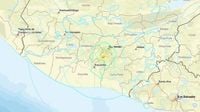A series of powerful earthquakes rattled Guatemala on Tuesday, July 8, 2025, leaving locals shaken and prompting emergency responses across the region. The seismic activity, centered near the city of Amatitlán just a few miles from Guatemala City, caused injuries, structural damage, and landslides, while authorities scrambled to assess the full scope of the impact.
The sequence began at 3:11 p.m. local time with a magnitude 4.8 earthquake southwest of Guatemala City. Roughly 30 minutes later, a more intense 5.7-magnitude quake struck the same area, according to the United States Geological Survey (USGS). This was followed by nearly 40 aftershocks, including another notable 4.8-magnitude tremor about 15 minutes after the main shock. The epicenters were located near Amatitlán, approximately 3 miles (4.7 kilometers) from the capital, at shallow depths reaching up to 6.2 miles (10 kilometers).
The Guatemalan government, led by President Bernardo Arévalo, confirmed that the earthquakes caused several landslides, which buried five people. Two of those trapped were rescued and hospitalized, while three others received medical attention for related emergencies. Damage was widespread, particularly affecting homes constructed from sun-dried blocks, a common building material in the area. In response, community centers and emergency shelters were opened to support families displaced or reluctant to return to their damaged homes.
In a press briefing, President Arévalo explained the rationale behind suspending classes and work activities on Wednesday, July 9, in the departments of Guatemala, Escuintla, and Sacatepéquez. "The reason for these suspensions is so emergency management agencies can evaluate damages," he said, emphasizing the need for thorough inspections before normal activities resume.
Guatemala lies within the Pacific Ring of Fire, a notorious zone of tectonic activity encircling much of the Pacific Ocean. This region is prone to frequent earthquakes and volcanic eruptions, though it is not a single, unified fault system. Historical context underscores the region’s vulnerability: on February 4, 1976, a devastating magnitude 7.5 earthquake struck near Guatemala City, killing over 23,000 people and injuring more than 75,000. That quake destroyed or severely damaged hundreds of thousands of homes and left over a million people homeless, marking it as one of Central America’s deadliest natural disasters.
While the recent earthquakes did not reach such catastrophic levels, the tremors still caused significant distress. The nation's seismological institute reported a 5.2-magnitude quake shaking southern Guatemala, about 60 kilometers from the capital, during the afternoon. This event triggered a series of aftershocks ranging from magnitudes 3.9 to 5.6. Local media captured images showing damage to some buildings, though authorities did not immediately report any serious collapses or fatalities. As a precaution, the national disaster response agency urged residents to evacuate public and private buildings amid fears of further aftershocks.
The USGS recorded 90 reports from people who felt the 5.6-magnitude earthquake centered in Amatitlán at a depth of 10 kilometers (about 6.2 miles). This underscores the widespread impact of the tremors across the region, affecting both urban and surrounding rural areas.
Guatemala’s government and emergency services have mobilized to provide assistance and conduct damage assessments. Shelters have been established to accommodate displaced residents, and the suspension of work and school aims to facilitate safe inspections of infrastructure. The situation remains fluid as aftershocks continue to rattle the area, keeping residents on edge.
In the broader context, these earthquakes come amid a global pattern of seismic activity. Just one day prior, a 6.3-magnitude earthquake struck Riverton, New Zealand, at a depth of 22 kilometers, according to the USGS. This was preceded by several tremors in Alaska and California in early July, highlighting the persistent restlessness of the Earth's crust in various parts of the Pacific Ring of Fire.
President Arévalo’s administration faces the immediate challenge of managing the humanitarian response while preparing for potential further seismic events. The government’s swift action in suspending activities and opening shelters reflects an awareness of the risks posed by the region’s geology. For many Guatemalans, the recent earthquakes are a stark reminder of the country’s vulnerability to natural disasters and the importance of preparedness.
As emergency teams continue their work, the focus remains on ensuring the safety of residents and restoring normalcy. The recent tremors, though not as devastating as past quakes, have shaken communities and infrastructure, underscoring the ongoing threat posed by Guatemala's position within one of the world's most seismically active zones.



